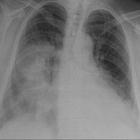sub acute extrinsic allergic alveolitis
Subacute hypersensitivity pneumonitis (a.k.a. subacute extrinsic allergic alveolitis) develops when hypersensitivity pneumonitis continues beyond the acute phase (i.e. continues for weeks to months) and still has the potential to resolve with treatment. While some publications suggest the disease needs to prevail for between 1-4 months to fall into this category , it is important to realize that the terms acute, subacute and chronic lie on a continuum.
Terminology
Although the symptomatic disease has been classically divided into acute, subacute, and chronic types, given contradictory definitions on what exactly constitutes the subacute phase, in common practice, the condition has been more frequently divided in acute/inflammatory type (non-fibrotic hypersensitivity pneumonitis) and chronic/fibrotic type (fibrotic hypersensitivity pneumonitis) .
Clinical presentation
Symptoms in the subacute phase of hypersensitivity pneumonitis are similar to, but less severe than, those in the acute phase. Symptoms are often prolonged over weeks to months. Patients may experience recurrent episodes of acute symptoms superimposed on a background of deteriorating respiratory function.
Pathology
Subacute hypersensitivity pneumonitis usually results from intermittent or continuous exposure to low doses of antigen and is histologically characterized by the presence of cellular bronchiolitis, non-caseating granulomas, and bronchiolocentric interstitial pneumonitis with a predominance of lymphocytes.
Radiographic features
On imaging, the features are mostly those of an inflammatory process (alveolitis) and, therefore, indistinguishable from the acute phase. Remember that the condition lies on a continuum and, depending on the time definition used to call it subacute, early fibrotic changes may be also described.
Treatment and prognosis
Steroids are often given for acute exacerbations and for prophylaxis against recurrence. Early diagnosis and removal of the offending antigen are still considered crucial in the prevention of recurrent disease and progression to fibrosis.
Complications
- progression to chronic hypersensitivity pneumonitis (fibrotic hypersensitivity pneumonitis)
Siehe auch:
- Konsolidierung der Lunge
- mosaikartige Verdichtungen der Lunge
- Hypersensitivitätspneumonitis
- Milchglasverschattungen
- air trapping
- chronic hypersensitivity pneumonitis
und weiter:

 Assoziationen und Differentialdiagnosen zu subacute hypersensitivity pneumonitis:
Assoziationen und Differentialdiagnosen zu subacute hypersensitivity pneumonitis:



